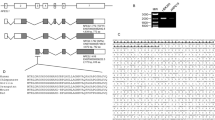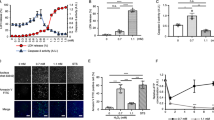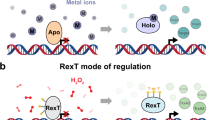Abstract
Thioredoxin is a redox-regulating protein, the expression of which is induced by various forms of oxidative stress. Thioredoxin controls the interactions of various transcription factors through redox regulation. In K562 cells, we have previously reported that hemin induces activation of the thioredoxin gene by regulating NF-E2-related factor (Nrf2) through the antioxidant responsive element (ARE). We showed here that tert-butylhydroquinone (tBHQ), an electrophile stressor, activates the thioredoxin gene through the ARE. In an electrophoretic mobility shift assay, a specific Nrf2/small Maf binding complex was induced by tBHQ and bound to the ARE. Overexpression of Nrf2 increased the tBHQ-induced thioredoxin gene activation through the ARE, whereas that of Jun and Fos suppressed the activation. The tBHQ-induced ARE binding activity was completely abrogated by an oxidizing agent, diamide, whereas 2-mercaptoethanol (2-ME) reversibly recovered the inhibitory effects of diamide, suggesting that ARE binding activity is redox-dependent. Moreover, overexpression of thioredoxin enhanced the ARE-mediated thioredoxin gene activation by tBHQ. Therefore, ARE-mediated induction of thioredoxin expression is a mechanism of enhancing signal transduction through the ARE in electrophile-induced stress responses.
This is a preview of subscription content, access via your institution
Access options
Subscribe to this journal
Receive 50 print issues and online access
$259.00 per year
only $5.18 per issue
Buy this article
- Purchase on SpringerLink
- Instant access to full article PDF
Prices may be subject to local taxes which are calculated during checkout






Similar content being viewed by others
References
Abate C, Patel L, Rauscher III FJ and Curran T . (1990). Science, 249, 1157–1161.
Blank V and Andrews NC . (1997). Trends Biochem. Sci., 22, 437–441.
Bloom D, Dhakshinamoorthy S and Jaiswal AK . (2002). Oncogene, 21, 2191–2200.
Friling RS, Bensimon A, Tichauer Y and Daniel V . (1990). Proc. Natl. Acad. Sci. USA, 87, 6258–6262.
Hirota K, Matsui M, Iwata S, Nishiyama A, Mori K and Yodoi J . (1997). Proc. Natl. Acad. Sci. USA, 94, 3633–3638.
Holmgren A and Björnstedt M . (1995). Methods Enzymol., 252, 199–208.
Igarashi K, Itoh K, Hayashi N, Nishizawa M and Yamamoto M . (1995). Proc. Natl. Acad. Sci. USA, 92, 7445–7449.
Igarashi K, Kataoka K, Itoh K, Hayashi N, Nishizawa M and Yamamoto M . (1994). Nature, 367, 568–572.
Itoh K, Igarashi K, Hayashi N, Nishizawa M and Yamamoto M . (1995). Mol. Cell. Biol., 15, 4184–4193.
Itoh K, Wakabayashi N, Katoh Y, Ishii T, Igarashi K, Engel JD and Yamamoto M . (1999). Genes Dev., 13, 76–86.
Kim YC, Masutani H, Yamaguchi Y, Itoh K, Yamamoto M and Yodoi J . (2001). J. Biol. Chem., 276, 18399–18406.
Meyer M, Schreck R and Baeuerle PA . (1993). EMBO J., 12, 2005–2015.
Miller EC and Miller JA . (1981). Cancer, 47, 2327–2345.
Nakabeppu Y, Oda S and Sekiguchi M . (1993). Mol. Cell. Biol., 13, 4157–4166.
Ney PA, Andrews NC, Jane SM, Safer B, Purucker ME, Weremowicz S, Morton CC, Goff SC, Orkin SH and Nienhuis AW . (1993). Mol. Cell Biol., 13, 5604–5612.
Oblong JE, Berggren M, Gasdaska PY and Powis G . (1994).J. Biol Chem., 269, 11714–11720.
Packer L and Yodoi J (eds). (1999). Redox Regulation of Cell Signaling and its Clinical Application, Marcel Dekker: New York, pp. 251–277.
Ramos-Gomez M, Kwak MK, Dolan PM, Itoh K, Yamamoto M, Talalay P and Kensler TW . (2001). Proc. Natl. Acad. Sci. USA, 98, 3410–3415.
Rushmore TH, Morton MR and Pickett CB . (1991). J. Biol. Chem., 266, 11632–11639.
Tsuji Y, Akebi N, Lam TK, Nakabeppu Y, Torti SV and, Torti FM . (1995). Mol. Cell. Biol., 15, 5152–5164.
Ueno M, Masutani H, Arai RJ, Yamauchi A, Hirota K, Sakai T, Inamoto T, Yamaoka Y, Yodoi J and Nikaido T . (1999). J. Biol. Chem., 274, 35809–35815.
Venugopal R and Jaiswal AK . (1998). Oncogene, 17, 3145–3156.
Verhagen H, Furnee C, Schutte B, Hermans RJ, Bosman FT, Blijham GH, Hoor F, Henderson PT and Kleinjans JC . (1989). Carcinogenesis, 10, 1947–1951.
Acknowledgements
We thank Ms Y Kanekiyo for secretarial help. We thank Dr K Itoh and Dr M Yamamoto for providing pEF-Nrf2, pEF-MafK vectors and anti-MafK antibodies. We also thank Dr Y Nakabeppu for pYN3215, pYN3215/c-Jun and pYN3215/c-Fos vectors. This study was supported by a grant-in-aid for Research and Development Program for New Bio-Industry Initiatives and by a grant-in-aid for Scientific Research from the Ministry of Education, Science and Culture, Japan. Yong-Chul Kim was a recipient of the New Energy and Industrial Technology Development Organization (NEDO) Junior Research Fellowship and is a recipient of the Research Fellowship of the Japan Society for the Promotion of Science (JSPS).
Author information
Authors and Affiliations
Corresponding author
Rights and permissions
About this article
Cite this article
Kim, YC., Yamaguchi, Y., Kondo, N. et al. Thioredoxin-dependent redox regulation of the antioxidant responsive element (ARE) in electrophile response. Oncogene 22, 1860–1865 (2003). https://doi.org/10.1038/sj.onc.1206369
Received:
Revised:
Accepted:
Published:
Issue Date:
DOI: https://doi.org/10.1038/sj.onc.1206369
Keywords
This article is cited by
-
Effects of JUN and NFE2L2 knockdown on oxidative status and NFE2L2/AP-1 targets expression in HeLa cells in basal conditions and upon sub-lethal hydrogen peroxide treatment
Molecular Biology Reports (2019)
-
Antiinflammation and Antioxidant Effects of Thalidomide on Pulmonary Fibrosis in Mice and Human Lung Fibroblasts
Inflammation (2017)
-
Hydrogen sulfide augments survival signals in warm ischemia and reperfusion of the mouse liver
Surgery Today (2015)
-
17β-Estradiol Ameliorates Light-Induced Retinal Damage in Sprague–Dawley Rats by Reducing Oxidative Stress
Journal of Molecular Neuroscience (2015)
-
Testing the Concept of the Interatomic Status of the NFE2L2/AP1 Pathway as a Systemic Biomarker for Examination Stress
Molecular Diagnosis & Therapy (2014)



